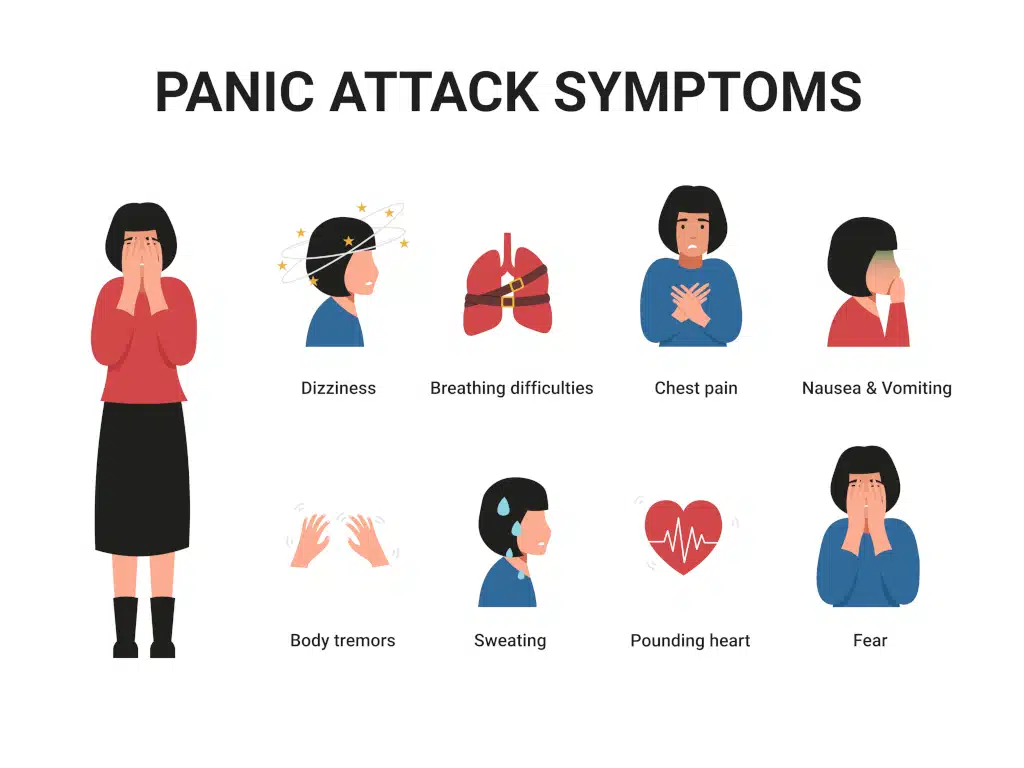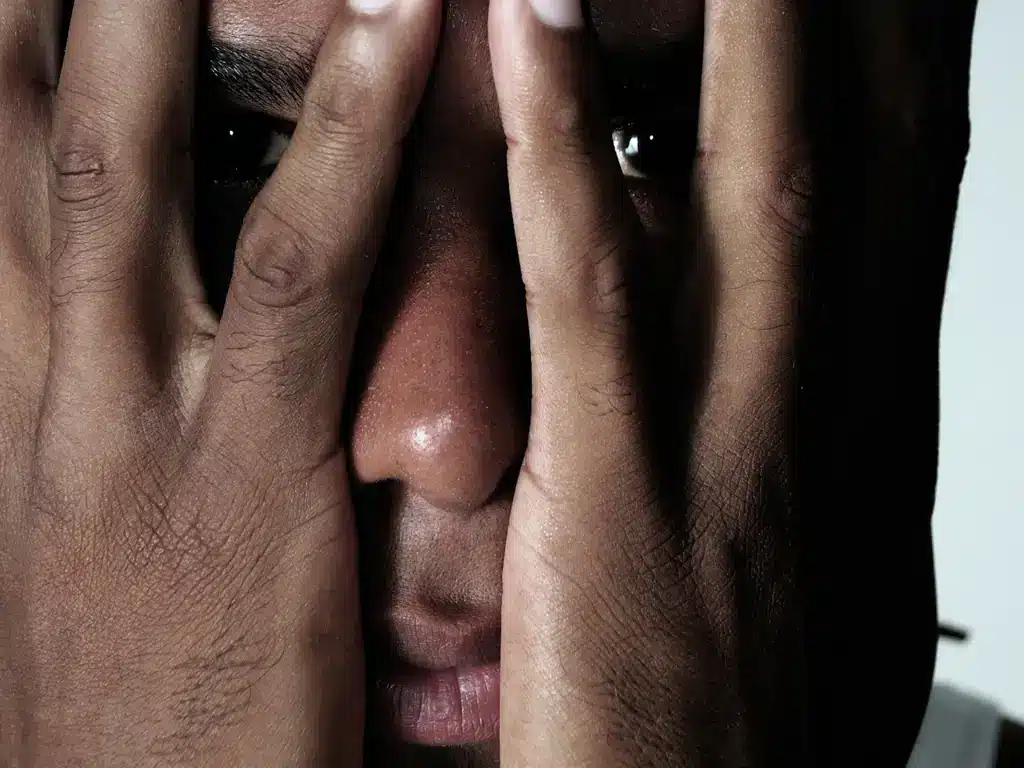What is a panic attack? Panic attacks can occur without warning, making a person feel scared beyond belief. A panic attack can also be referred to as an anxiety attack. The physical symptoms and overwhelming fear can be so severe a person ends up in an emergency room.
Understanding the signs, underlying causes and treatment options for both panic attacks and panic disorder is key in managing the intense fear, intense anxiety and other related mental health issues.
By understanding and learning about panic attacks, one will be better equipped to manage their symptoms associated with such experiences and if the panic attack is happening to a loved one, learning what to do when an unexpected panic attacks occur will become valuable.
Let’s delve into the topics of panic attacks & panic disorder for greater self-awareness.
Short Summary
- Recognize symptoms of panic attacks, such as intense fear and racing heartbeats.
- Explore potential causes related to the amygdala and chemical imbalances.
- Seek professional help for severe or frequent episodes, utilizing treatments like CBT & medications.
Understanding Panic Attacks

In most cases, panic attacks manifest as sudden intense fear with accompanying physical symptoms like a racing heartbeat and shortness of breath. These unexpected episodes can lead to nausea and have been linked to the brain’s function, nervous system problems, or imbalances in one’s bodily chemistry. Though not all people who go through these bouts suffer from panic disorder, understanding the warning signs along with how to prevent panic attacks and potential triggers is necessary for proper mental health management going forward.
The amygdala—a part of our brains that governs emotion processing—as well as disturbances within chemical messengers are thought to contribute greatly toward initiating unexpected panic attacks and panicked reactions.
When considering ways on how best to prevent future panic attack symptoms and panic disorder symptoms, while maintaining overall psychological wellbeing it is best to look at both the role of the amygdala and the possibility of chemical imbalances.
Since factors surrounding this condition are diversely complex ranging from biology up to psychology. Assessing them individually allows us greater ability towards addressing an individual’s personal circumstance before trying out any specific treatment plan. To address anxiety spells such as unexpected panic attacks and recurring panic attacks. In addition, noticing that particular places, situations or activities seem to trigger panic attacks.
The Role of the Amygdala
The amygdala, often referred to as the ‘fear center’ of our brains, is an integral part in the development of panic attacks. Its purpose is to produce frightful emotions when faced with perceived dangers and could possibly be a factor that sets off these events.
It can be difficult pinpointing what exactly triggers such panic attack episodes since they are caused by numerous things including anxiety, stress, genetics and even certain types of food or beverages.
Being aware of how this portion of the brain works may help people gain control over their next panic attack by diminishing the frequency and intensity they are feeling.
Seeking expert advice and undergoing cognitive behavioral therapy (CBT) can address root causes behind the physical symptoms of a panic attack, panic disorders, and or an anxiety disorder.
Chemical Imbalances
It has been found that an inequality in neurotransmitters like serotonin can develop panic disorder. In addition, this inequality can contribute to a panic attack, anxiety disorder and varying levels of panic disorders. These differences in the brain chemistry may cause heightened feelings of fear and unease, making everyday life more difficult for those affected.
In order to better manage further attacks it is important to seek out a diagnosis from a psychiatrist or experienced mental health professional. Options such as cognitive therapy, talk therapy or medication which are designed towards improving mental health can reduce symptoms. Seek medical a psychological evaluation or assistance to help regulate any imbalances leading up to symptoms of panic attacks and/or panic disorder.
Recognizing Panic Attack Symptoms

Being able to recognize the signs and physical symptoms of a panic attack is essential in order to obtain timely help and properly cope with such episodes. Typical physical sensations may include chest pain, trouble breathing, overwhelming anxiety, and feeling powerless. Quickly coming to an apex within 10 minutes a panic attack can become life threatening and require emergency medical care. For some a panic attack is described like they are dying.
Panic attacks can take place almost anywhere at any given moment. Thus it’s key to be prepared for them by knowing about possible indicators.
We will discuss the implications of two main types of indications – chest torment plus breathlessness – along with how losing control during these incidents affects someone mentally or emotionally.
Chest Pain and Breathing Difficulties
Individuals who are struggling with panic attacks may experience physical symptoms such as chest pain and difficulty breathing, including shortness of breath or hyperventilation. These symptoms can be very similar to those experienced during a heart attack, it is essential that emergency medical care is sought right away in order to differentiate between the two conditions. Doing this will decrease fear and worry surrounding these signs, enabling individuals affected by panic attacks to manage them more effectively.
Losing Control
When it comes to panic attacks, fear and anxiety are some of the common psychological symptoms experienced. There is an overwhelming feeling of not being able to maintain control during these episodes, which can intensify these feelings even more. Panic attacks can be triggered by certain situations or experiences that can make panic attacks worse, adding yet another layer that must be managed in order to cope with them successfully.
Understanding and recognizing all the different aspects associated with a panic attack – from its symptoms such as worry and despair up until what triggers one – is essential for any effective action towards regaining power over those intense sensations caused by this phenomenon.
Panic Disorder: A Closer Look

People with panic disorder may suffer from panic attacks that occur suddenly and unexpectedly. These panic attack episodes can cause anticipatory anxiety, fear avoidance behaviors and have a major impact on daily life activities. It is important to be aware of the symptoms of this mental health condition in order to get an accurate diagnosis so as to seek suitable treatment which could help manage it effectively for better overall psychological well-being.
There are connections between panic disorder and other anxieties along with recurrent panic attack episodes playing a role in its development process.
Anxiety Disorders
Panic disorder is one of many forms of anxiety disorders, leading to significant distress and difficulty with daily activities. This issue can be identified by signs including fear, worry, and tension that limit functioning in life.
The symptoms associated with panic disorder as well as other types of anxieties are generalized anxiety issues, social concerns, phobias linked to a specific thing or situation. Agoraphobia (fear due to wide open spaces), feelings caused by being away from home or loved ones, selective mutism which stops someone from speaking in certain situations.
Treatment for these types of mental health conditions involves cognitive behavioral therapy (CBT), usage of medications if needed, along with relaxation techniques and learning to practice mindfulness.
Repeated Panic Attacks
Unexpected panic attacks, which are a key symptom of panic disorder, can greatly impair mental health. Intense anxiety as fear overwhelms a person and they know a panic attack is coming is a traumatic event that can cause abdominal distress and even a choking feeling.
Exposure therapy addressing traumatic events, talking therapies to help overcome fears and examining family history are all treatment options addressing risk factors of anxiety and panic attacks.
Cognitive behavioral therapy (CBT), taking medication like serotonin-norepinephrine reuptake inhibitors can help regulate mood and relieve depression which can be a contributing factor for someone experiencing a panic attack repeatedly.
Diagnosing Panic Attacks and Panic Disorder
When it comes to addressing panic attacks and diagnosis of panic disorder, one must adhere to the DSM-5 criteria. A mental health professional should be consulted if there is a pattern in experiencing ongoing or regular panic attack episodes as they can provide an official diagnosis while ruling out any physical causes behind the symptoms.
The most common treatment for anxiety attacks involves combining cognitive behavioral therapy with medications like antidepressants (serotonin-norepinephrine reuptake inhibitors) to address both physiological signs along with psychological effects such as worry, fear and other related conditions accompanying a person’s experience.
It is crucial that proper medical history gets reviewed thoroughly before undertaking any sort of measures which target these issues effectively at hand!
DSM-5 Criteria
According to the DSM-5, the apparent cause of a panic disorder can be identified through recurrent episodes of extreme fear and distress that peak in only a few minutes. Mental health care professionals should adhere to these criteria when diagnosing this condition so individuals can get proper treatment for controlling their symptoms and enhance overall mental wellbeing.
The guidelines state that an individual experiencing such attacks will have intense emotions like terror or fear which erupt abruptly from nowhere without warning.
Treatment Options for Panic Attacks and Panic Disorder at CarePlus New Jersey
For treating panic attacks and panic disorders, cognitive behavioral therapy (CBT) and medications offer effective solutions. CarePlus New Jersey has onsite psychiatrists and therapists that follow best practices and can treat adults, adolescents, and children facing panic attacks and panic disorder.
Combining individual therapy and or group therapy with medication management can be a winning approach for some, and others do fine in one on one therapy. Symptoms of panic disorder can feel physical versus emotional. Learning how to recognize a panic attack coming on and experiencing symptoms from trauma in the past are specific issues to explore. CarePlus New Jersey can guide a person to the right types of treatment and empower them on their journey.
Cognitive Behavioral Therapy (CBT)
Cognitive behavioral therapy (CBT) is a form of psychotherapy which has been proven to be beneficial for those suffering from panic attacks and panic disorder, as well as other anxiety disorders. CarePlus New Jersey offers this type of therapy and helps patients identify negative thought patterns and behaviors that lead to or perpetuate the symptoms of a panic attack.
CBT also helps patients develop effective coping strategies so they can effectively manage their signs and symptoms of anxiety as well as their panic attacks going forward. The structure involved in CBT involves weekly sessions between patient and therapist where unhelpful thought processes are discusses, challenged, and altered accordingly.
CBT is this an extremely popular therapy among medical professionals and patients alike when treating cases concerning panic disorder along with other forms of anxiety disorders.
Medications
Managing panic attacks and panic disorder often requires medications such as antidepressants along with other treatment options. It is important to consult a healthcare provider in order to identify the most suitable drugs for individual patient needs.
Treatment also involves addressing sleep patterns, healthy diet and lifestyle changes that could improve the root causes of these anxiety.
Although some symptoms can be alleviated through medical intervention, CarePlus New Jersey believes in addressing all underlying issues completely. Therapy is always considered when treating anxiety symptoms.
Preventive Measures and Coping Strategies
Identifying triggers and relaxation techniques are key for avoiding panic attacks and maintaining a healthy mental state. In order to reduce the recurrence or intensity of these anxiety episodes, it is imperative that individuals discover what prompts their fear response as well as implement various strategies such coping mechanisms in therapy, breathing exercises, muscle tension release activities, etc.
By taking active steps towards understanding themselves better, they can be in control of their wellbeing instead of being controlled by anxiety-inducing situations.
Identifying Triggers
People can decrease the chance of panic attacks occurring in the future and improve their mental health by understanding specific instigators that may bring about these episodes. Triggers could include stress, medication or other environmental elements, taking suitable steps to avoid them such as engaging in relaxation techniques or avoiding certain activities is important for long term benefits.
Relaxation Techniques
Relaxation techniques such as deep breathing, progressive muscle relaxation, mindfulness meditation and exercise can be a great help in managing the symptoms of panic attacks and panic disorder. By taking slow breaths that focus on each inhalation and exhalation or systematically tensing then releasing different muscles throughout your body, you may find it easier to reduce feelings of anxiety while also helping prevent future episodes. Including these methods into one’s daily life could not only aid with controlling reactions during an attack, but might just improve overall mental health too.
Supporting Someone Experiencing a Panic Attack
During a panic attack, it is important to remain calm and guide the individual’s breathing. Offer words of comfort as well as support in order for them to feel less scared or anxious. Suggesting professional help through helplines and self-help groups can be beneficial too.
Reassure someone who is going through such an episode that there are professionals they can reach out if needed so their fear isn’t overwhelming anymore – this may aid in relieving some of the stress caused by anxiety associated with a panic attack.
When to Seek Professional Help
It is important to receive emergency medical assistance for symptoms of a severe panic attack, such as chest pain and trouble breathing. This will make sure that no life-threatening condition like a heart attack exists. When someone has recurring or frequent episodes of this kind, they should get in touch with their healthcare provider who can diagnose the problem correctly and ensure there are not other physical factors underlying these symptoms.
By consulting qualified help from experts one can access all necessary support needed to adequately handle attacks caused by panic disorder efficiently. CarePlus New Jersey is available for you or your loved one.
Summary
Realizing the indications, reasons and treatment alternatives for panic attacks and anxiety issues is significant for healing. By recognizing triggers, looking for proficient help combined with procedures such as medication and therapy, like cognitive behavioral therapy (CBT) or relaxation techniques, patients can improve their signs and symptoms, enabling them to lead a more joyful lives.
It’s important not forget that you’re not alone when it comes to your struggles against panic attacks and panic disorder. With correct support along with resources, any individual can overcome difficulties successfully.
Frequently Asked Questions
What does a panic attack feel like?
Sudden and unexpected episodes of intense fear are known as panic attacks. Symptoms may include a rapid heartbeat, trembling, perspiration, or difficulty breathing. These signs can appear unexpectedly at any time without warning, which makes them difficult to manage for those who experience them. Physical manifestations such as shaking hands or shortness of breath often accompany these bouts of anxiety and terror associated with the attack itself. Panic attacks can bring extreme discomfort, but awareness about this issue will be key in helping people cope better when they do occur.
What are 4 signs of a panic attack?
Panic attacks can be triggered by a range of situations, including fear and stress. Characteristic signs such as chest pain, heart palpitations, shortness of breath or feeling like doom is coming are intense physical and psychological experiences that may be alarming but usually pass quickly. It’s important to identify the symptoms so one has access to treatment options when needed.
What is the difference between a panic attack and panic disorder?
An episode of severe fear and/or anxiety is known as a panic attack. Those who experience recurring episodes of these types of attacks are diagnosed with having panic disorder. In either case, the person’s overwhelming emotion can be extremely intense for short bursts at a time.
What are some common triggers of panic attacks?
Triggering factors for panic attacks may include environmental causes, past traumatic events, medication side effects and high levels of stress.
How can cognitive behavioral therapy (CBT) help with panic attacks and panic disorder?
CBT assists people in identifying and transforming unfavorable thought processes and actions associated with panic attacks and disorder, allowing for better outcomes regarding symptom control. By means of this treatment strategy, those suffering can learn to detect their adverse reflections as well as practices while substituting them with more constructive approaches that will aid in the managing of symptoms thus leading to improved mental health overall.

Dana Czachorowski, MA, LPC
Dana Czachorowski, MA, LPC has been working with children and families for the las 15 years. She has spent the majority of her time working as part of New Jersey’s Children’s System of Care and is currently Senior Director of Children’s Mobile Response and Stabilization Services in Bergen County at Care Plus NJ. Dana specializes in working with families in crisis.

